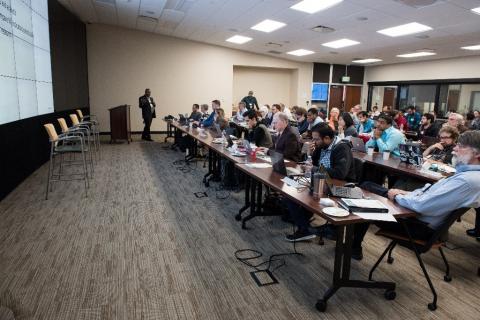Capabilities
 |
 |
Grid Control Room Operations Research
The EIOC includes two fully functional, and configurable grid control rooms that can be used to replicate nearly any operational control room environment, from generation to transmission to distribution to buildings and end loads, as well as configurable network security and cyber operations. Designed with real industry control room capabilities and use cases in mind, these control rooms make it possible to design, test, and evaluate tools and concepts in a setting that mirrors current industry conditions and operational scenarios. The EIOC control rooms feature two 40-foot-wide, 10-foot-tall multiplexing video wall systems that can display a wide range of content from multiple sources.
Because the EIOC has two fully functional and configurable control rooms it enables PNNL to conduct interactive studies between control room operations, enabling interactive simulations with North American Electric Reliability Corporation (NERC) functional entities. These include transmission operator to reliability coordinator, transmission operator to balancing authority, transmission operator to distribution operator, or transmission operator to network security operations center. The realistic control room environment provides opportunities for human factors studies, visual analytics, cognitive systems engineering, human in-the-loop, human-machine interfaces, human-machine teaming, and evaluation of new tools and technologies relative to operator cognitive overload.
Emergency Operations, Incident Management and Continuity of Operations
The EIOC is a great resource for testing and validating energy assurance plans and remedial action schemes in a secure, realistic environment. The EIOC serves as a technology pipeline where new tools and technologies are evaluated against the end user’s needs and desires. Realistic simulated events and emergency scenarios with specific use cases are developed here that go beyond today’s simple desktop exercises.
Utilities and emergency responders are also entering into agreements with PNNL to use this facility for integrated command and control when an emergency command center is needed.
Data Hosting, Curation, and Live Data Feeds
The EIOC maintains and operates its own secure, dedicated server enclave to host valuable data sets that contain both real and synthetic grid data that can be used for model development, verification, and validation. The EIOC is capturing live, streaming synchrophasor data feeds from utilities via secure connections. We also host many unique utilities and grid data sets and have many more archived, with the ability to curate these data sets for research purposes.
High-Performance Computing
The EIOC leverages PNNL’s advanced computational capabilities that enable complex computing processes and calculations – such as contingency analyses, security-constrained unit commitment, and dynamic state estimation – to run at ultra-high speeds.
PowerNET
The EIOC is connected with the PowerNET Testbed – a multi-user, remotely accessible, experimental laboratory focused on testing and evaluating power systems for grid modernization research. For example, PNNL’s PowerNET testbed enables peer researchers to use the EIOC to test models, software, hardware, and middleware, so researchers can develop and test new ideas and concepts. Designed to be joined with other testbeds to tackle large-scale problems, PowerNET decreases up-front costs for equipment, reducing the barriers for non-power system engineers and grid technology start-ups to experiment with power system equipment.
PNNL Cyber-Physical Systems Testbed (PRIME)
Where PowerNET brings the cyber-physical components and interoperability of hardware-in-the-loop, PRIME ties it all together and makes it usable through an industry standard energy management system (GE’s e-Terra Element Management System) driven by a power system engineering software tool (PowerWorld). PRIME enables us to conduct advanced simulations of grid operations, with real-time simulated grid events (e.g., forced oscillations), using an energy management system operator interface, where the operators can see in real-time the consequences of the actions they take on the system in response to the simulated event.
Cybersecurity
PNNL is a leader in developing advanced capabilities to protect our grid from cyber-attacks. In collaboration with the EIOC, PNNL maintains a NSOC-Network Security Operations Center capability in the EIOC to provide a working space for researchers to develop next generation cyber solutions. These solutions include advanced visualization, analytics, notification processes, and forensic methods for information sharing and situational awareness that directly support electric grid operations and cybersecurity.
Grid Operations Training and Exercises
The EIOC is used to provide training for nearly all aspects of grid operations. Training ranges from basic introductory and refresher courses for utility management to operator dispatch, as well as advanced training in the use of new, novel technologies and approaches, national security-related contingencies and procedures, incident management and emergency response, desktop exercises, and energy assurance planning.